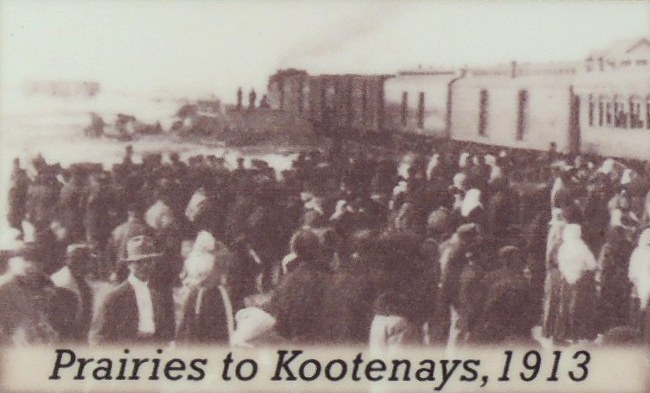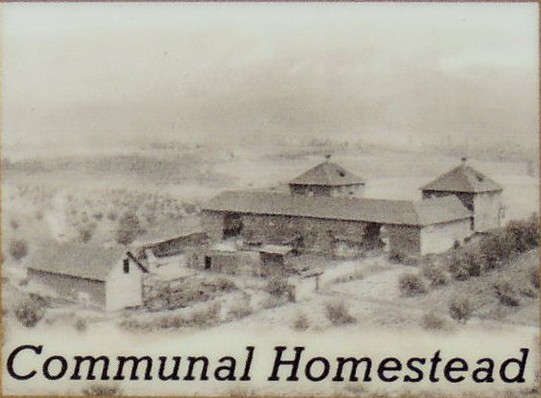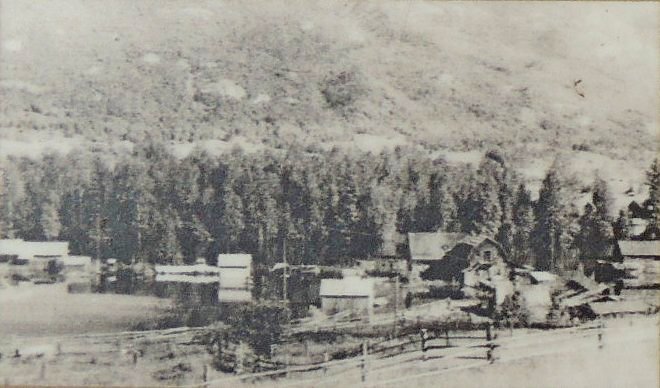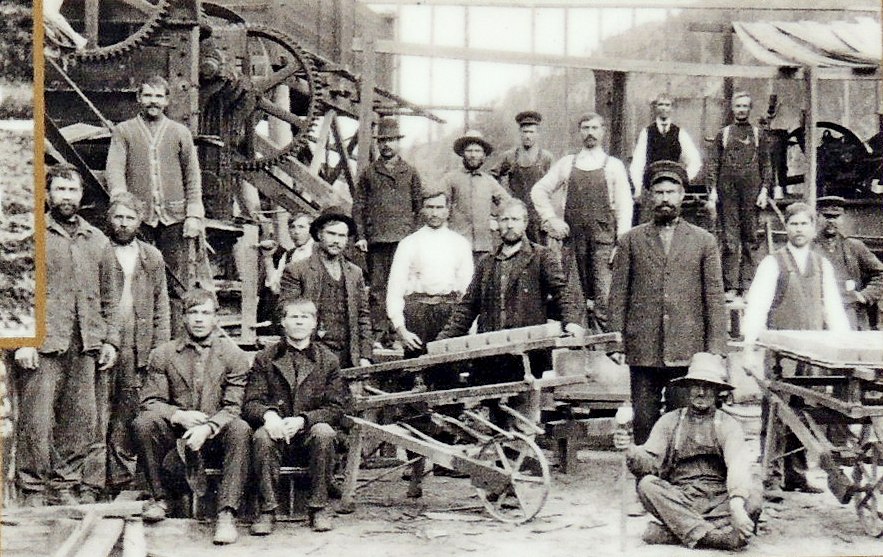|
 Doukhobor History - 17th Century to 1987 - Winlaw, BC, Canada Posted by:  T0SHEA T0SHEA
N 49° 37.581 W 117° 32.861
11U E 460445 N 5497231
Along the 50 kilometre Slocan Valley Rail Trail one will encounter many signs and plaques relating the stories of the valley, stories of the river, the flora and fauna and of the people.
Waymark Code: WMRNY6
Location: British Columbia, Canada
Date Posted: 07/14/2016
Views: 1
This sign, about 2 kilometres north of Winlaw, deals with one group of people of the valley, the Doukhobors, who came here in 1912, building houses, farms, businesses, factories and communities. They remain the major constituent of the populace of the southern Slocan Valley. Much of the story of their time in the Slocan Valley unfolds in the timeline below, and is expanded upon in a narrative further below.
A Doukhobor Historical Overview
17th to 19th Century - Doukhobor ideals on pacifism, simple living and personal responsibility evolve in Russia. Czarist persecution of pacifist Doukhobors intensifies after the Burning of Arms in 1895. 1899 - With the help of Leo Tolstoy and the Quakers, and with the Canadian Government eager to see the prairies settled, some 7500 Doukhobor immigrants homestead land in what in now Saskatchewan.
1908 to 1917 - Under the leadership of Peter "Lordly" Verigin, over 15,000 acres in the Kootenay/Boundary area are purchased and settled by 5000 Doukhobors. Lands and industries are worked and owned communally by the Christian Community of Universal Brotherhood (CCUB). The communities and communal enterprises prosper.
1924 - Doukhobor leader Peter V. Verigin and eight others are killed in a mysterious unsolved explosion of a CPR train near Grand Forks. This event intensifies community unrest and suspicions. The Verigin funeral is attended by 7000, the largest gathering in Kootenay history.
1937 - In spite of having many assets the Christian Community of Universal Brotherhood is bankrupted by its creditors. Community-held land and industry is lost and friction amongst different groups of Doukhobors increases. Government eventually buys the communal assets, and sells much of the land back to individual Doukhobors.
1920s to 1980s - Disagreement between most Doukhobors and government over schooling and registration issues grows. Hundreds of incidents of violent protest occur throughout the Kootenays.
1982 to 1987 - Mediation by The Expanded Kootenay Committee on Intergroup Relations helps to end violence and builds bridges amongst major Doukhobor groups, governments and Kootenay communities.
From the Slocan Valley Rail Trail Sign
![]() Who Are The Doukhobors?
 With roots in the Russian empire and Russian Orthodox Christianity, the Spirit Wrestlers or Doukhobors oppose militarism. Their communal living experiments in Saskatchewan and BC are the largest in North American history. They believe that the rights and responsibilities of individuals supercede those of Church or Government. Doukhobors pioneered ideals of intentional community, pacifism, shared work, self-sufficiency and spirituality. Today Doukhobors make up a large percentage many Slocan Valley Communities.
With roots in the Russian empire and Russian Orthodox Christianity, the Spirit Wrestlers or Doukhobors oppose militarism. Their communal living experiments in Saskatchewan and BC are the largest in North American history. They believe that the rights and responsibilities of individuals supercede those of Church or Government. Doukhobors pioneered ideals of intentional community, pacifism, shared work, self-sufficiency and spirituality. Today Doukhobors make up a large percentage many Slocan Valley Communities.
First Settlers
After buying the first Doukhobor lands in the Kootenays leader Peter V. Verigin is quoted as saying: "As for the forest, it is our friend; we will use it to build our homes. It's splendid timber; some soil will need irrigation, but there is water everywhere ... cheap, clear, and clean. No schools, No government interference. An ideal place to build a brotherhood." Simeon Reibin, 1952, cited by Tarasoff.
Peaceful Toil and Co-operation
Slocan Valley settlements north of Winlaw (including Appledale, Perry Siding and Hills) are rich in Doukhobor heritage. A typical early communitarian enterprise in the Valley was Kirpichnoye or Claybrick, the communal settlement and brick factory once located at this site.
 This was Kirpichnoye or Claybrick
This was Kirpichnoye or Claybrick
The first Doukhobors moved to this site in 1912. Houses were built both on the west side of the railway toward the river (Lower Village) and on the east side of the tracks (Upper Village). These villages were completely self-sufficient.
The bricks produced here were used for building through the Slocan and Kootenay regions. Kirpichnoye pioneers also grew vegetables, berries and fruit and kept chickens, cows, and horses.
Strong Leadership or Personal Independence?
The balancing of personal responsibility with obedience to the directions of charismatic leaders may have been problematic in the past. As individuals and groups coped with change in difficult times (1920s - 1980s), protests against government policies or disagreements amongst Doukhobor factions became a fact of Kootenay life.
 The Irony of Zealot Protests
The Irony of Zealot Protests
While pacifism and non-violence are key Doukhobor principles, arson - and later, bombings - were used by some to protest against government and perceived corporate enemies. Hundreds of incidents destroyed millions of dollars of property and threatened lives. Arson was also used by some zealots against other Doukhobors whom they regarded as succumbing to materialism or accommodating government. Arsons and bombings peaked between 1940 and 1962 - a year in which there were 39 incidents and a bomber was killed.
Perry Siding Demonstration
In 1953 Doukhobor children were being seized by police for not attending school. Many "Sons of Freedom" Doukhobors protested at Perry Siding. Over 140 were arrested and many imprisoned. One hundred Doukhobor children were sent to a government school in New Denver. Increased violence and strong police action produced tension throughout the Kootenays over the "Doukhobor problem".
 Through the 1950s and 1960s, many Canadians erroneously believed that all Doukhobors were to blame for this violence.
In fact peaceful Doukhobors as well as government and communities were often the victims. The actions of the minority that sanctioned arson, bombings and nudity damaged the reputation of all Doukhobors.
Through the 1950s and 1960s, many Canadians erroneously believed that all Doukhobors were to blame for this violence.
In fact peaceful Doukhobors as well as government and communities were often the victims. The actions of the minority that sanctioned arson, bombings and nudity damaged the reputation of all Doukhobors.
Peace and Reconciliation
After the losses and trials of the preceding half century, the mediation of the Expanded Kootenay Committee on Intergroup Relations was welcomed and successful. People were tired of past destruction and most sought a return to peace. Violent protest in the Kootenays ceased in the 1980s.
For more information about this story visit: The Doukhobor Discovery Centre Museum and The MIR Centre For Peace. Both are located in Castlegar.
In the Slocan Valley today Doukhobors continue their work as community leaders and peacemakers.
From the Slocan Valley Rail Trail Sign
![]()
Admission fee? (Include URL/link in Long Description to website that gives the current fee): no

|
Visit Instructions:At least one good photo you have personally obtained and a brief story of your visit. Any additions or corrections to the information about the Waymark (for instance, have the hours open to the public changed) will be greatly appreciated.
Recent Visits/Logs:
| There are no logs for this waymark yet. |
|
|
|
|